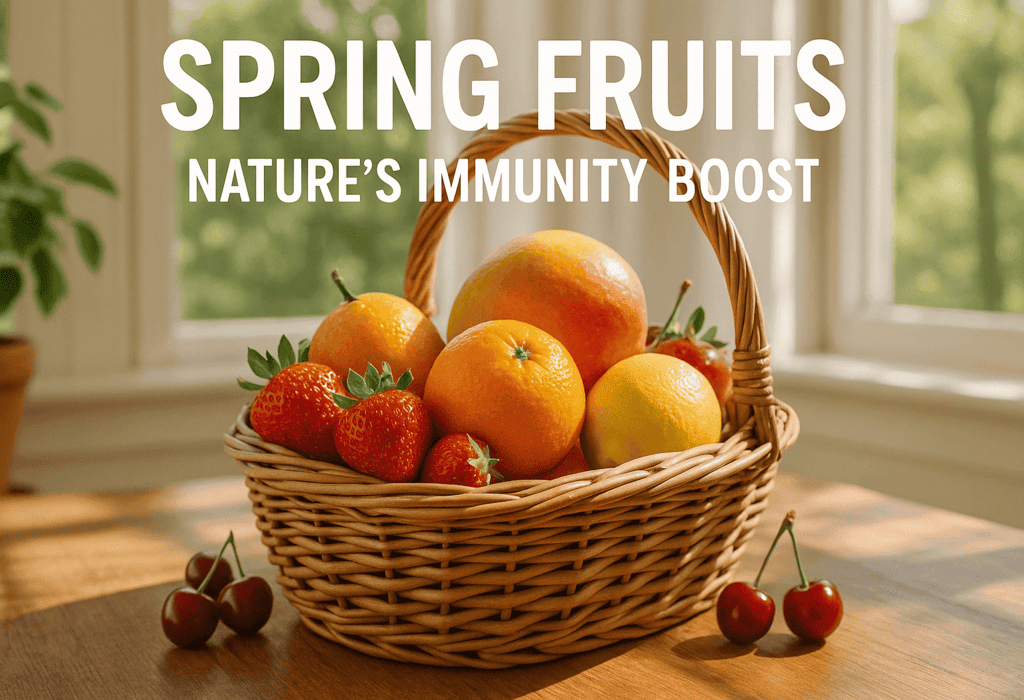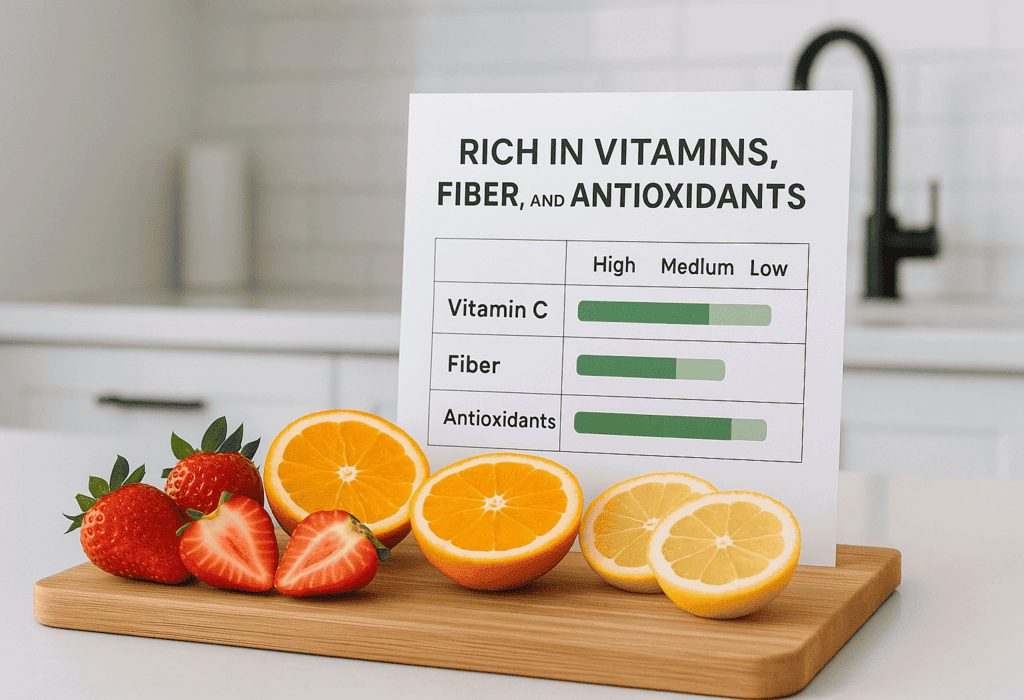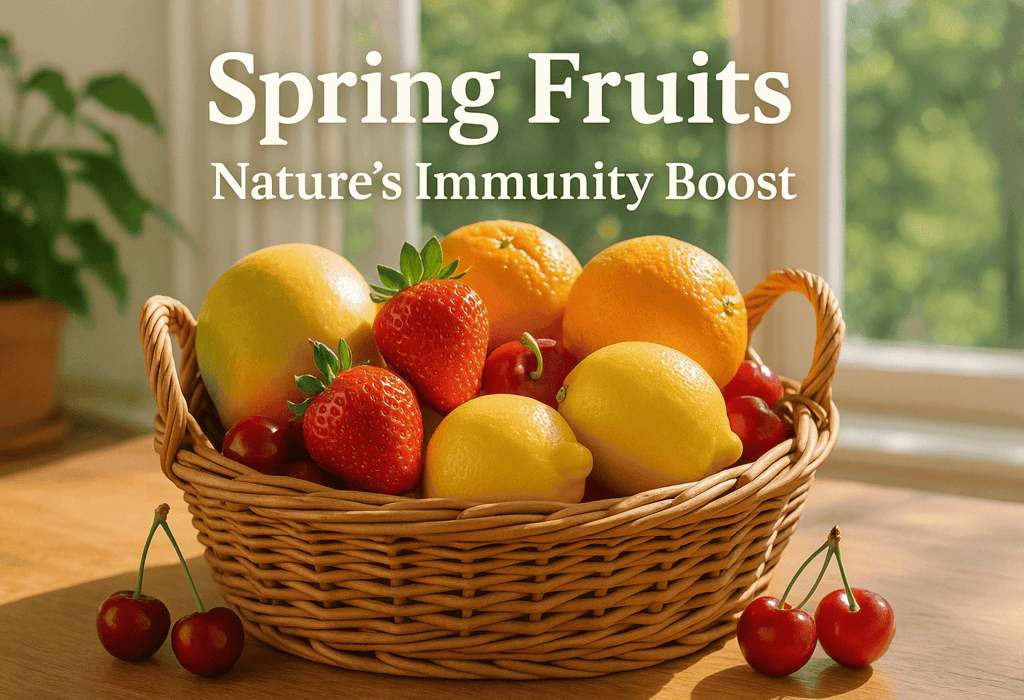
Introduction
Spring is the season when markets brim with fresh, colorful fruits that are not only delicious but also densely packed with nutrients. Incorporating spring fruits into your daily diet is an easy, affordable, and evidence-based way to boost immune function, support cardiovascular health, and reduce the risk of chronic disease. This article explains the science-backed benefits of seasonal fruits, offers practical guidance on selecting and storing them, and provides meal ideas and charts to help you make the most of spring produce. The language and structure are optimized for search engines (SEO-friendly) and for clear translation.
Key Points (at a glance)
- Spring fruits are rich sources of vitamin C, dietary fiber, potassium, and plant antioxidants (flavonoids and polyphenols).
- Regular consumption of fruits is associated with lower cardiovascular risk, reduced all-cause mortality, and decreased incidence of hypertension and other non-communicable diseases. PMC
- Vitamin C and other fruit-derived phytochemicals support innate and adaptive immune function, helping the body resist infections and recover faster. PMC
- Global health authorities recommend consuming at least 400 g (≈5 portions) of fruits and vegetables daily as part of a healthy diet; higher intake may confer greater protection. Organisation mondiale de la santé+1
- Choosing ripe, undamaged fruits and storing them properly preserves nutrient density and flavor.

The Nutritional Power of Spring Fruits
Spring fruits such as strawberries, citrus (oranges, lemons), cherries, apricots, and mangoes deliver concentrated nutrition in small portions. Typical nutritional highlights include:
- Vitamin C — critical for collagen synthesis, antioxidant defense, and immune cell function.
- Dietary fiber — supports digestion, glycemic control, and satiety.
- Potassium and magnesium — support healthy blood pressure and cardiac rhythm.
- Polyphenols and flavonoids — plant compounds that reduce oxidative stress and inflammation.
A large body of epidemiological evidence links higher fruit and vegetable intakes with lower risk of chronic disease. A comprehensive meta-analysis of cohort studies found consistent associations between fruit and vegetable consumption and reduced risk of cardiovascular disease, cancer, and premature death. PMC
Table 1 — Typical nutrients in common spring fruits
| Fruit | Top nutrients | Noted benefits |
|---|---|---|
| Strawberry | Vitamin C, folate, polyphenols | Anti-inflammatory, immune support |
| Orange | Vitamin C, potassium, folate | Blood-pressure support, immunity |
| Lemon | Vitamin C, flavonoids | Antioxidant support, flavoring |
| Mango | Vitamins A & C, fiber | Vision, skin health, digestion |
| Cherry | Melatonin precursors, anthocyanins | Anti-oxidative support, sleep regulation |
(Nutrient profiles vary by variety and ripeness; values shown as general highlights.)
How Spring Fruits Support Immunity — The Evidence
Vitamin C is the single most-cited nutrient in fruit-related immune science. It supports neutrophil function, lymphocyte activity, and acts as a systemic antioxidant to protect immune cells from oxidative damage. Reviews and mechanistic studies summarize how adequate vitamin C intake improves several aspects of host defense and may reduce duration and severity of some respiratory infections. PMC+1
Beyond vitamin C, flavonoids and polyphenols—abundant in berries and citrus—modulate inflammatory signaling pathways and can enhance mucosal defenses. Recent literature also links higher serum vitamin C and antioxidant status with lower rates of respiratory infections in children and adolescents. Frontiers+1

Fruits, Heart Health, and Chronic Disease Prevention
Numerous prospective studies and meta-analyses show that higher fruit consumption is associated with lower incidence of hypertension, coronary heart disease, stroke, and overall mortality. For example, dose–response analyses indicate meaningful declines in cardiovascular risk even with moderate increases in fruit intake. The World Health Organization and major nutrition guidance documents encourage consuming at least 400 g of fruits and vegetables per day for non-communicable disease prevention. Organisation mondiale de la santé+1
A 2017 large pooled review found that increasing daily portions of fruits and vegetables toward 10 portions per day could produce large public health gains, although most people benefit from reaching the current 5-a-day standard first. This work highlights that seasonal whole fruits—not fruit juices—are the preferred form due to fiber and satiety properties. Imperial College London+1
Effects by Age Group: Tailoring Fruit Intake
- Children: Nutrient needs for growth and immune development make fruit a vital, child-friendly source of vitamins, minerals, and fiber. Fruits also provide hydration and natural sugars in controlled portions.
- Adults: Regular fruit intake supports cardiovascular health, weight maintenance, and cognitive resilience through antioxidants and micronutrients.
- Older adults: Fruits can help reduce inflammation, support endothelial function, and provide micronutrients often lacking in aging diets.
A 2023 analysis of global disease burden attributed a substantial fraction of non-communicable disease risk to diets low in fruits, underscoring the public-health importance of increasing fruit consumption across all ages. PMC
Practical Guidance: Choose, Store, and Prepare for Maximum Benefit
Choosing fruit: Look for bright color, pleasant aroma, and firm (but not rock-hard) texture. Avoid fruit with deep bruises or mold. Local, seasonal varieties often offer the best flavor and nutrient profiles.
Storing fruit: Most spring fruits store best when refrigerated in a perforated bag or loosely covered container. Some fruits, like bananas and certain stone fruits, continue to ripen at room temperature—buy accordingly depending on when you plan to eat them.
Preparing fruit: Wash under running water to remove residues. Eat whole fruits when possible to retain fiber. Use fruit to replace desserts and sugary snacks.

Everyday Ways to Add Spring Fruits to Your Diet (Recipes & Ideas)
- Breakfast: Greek yogurt with sliced strawberries and a sprinkle of chopped nuts.
- Smoothie: Blend mango, orange juice (or water), spinach, and a spoonful of plain yogurt.
- Salad booster: Toss cherries or mandarin slices into a leafy green salad with grilled chicken.
- Snack: Apple or pear slices with nut butter, or fresh orange segments.
These simple strategies boost vitamin, mineral, and fiber intake while keeping meals balanced and satisfying.
Common Myths and Mistakes
- Myth: “Fruit causes weight gain.” Reality: Whole fruits are high in fiber and water and tend to increase satiety; when consumed in moderation, they support healthy weight management.
- Mistake: Over-relying on fruit juices. Juices lack fiber and concentrate sugars; whole fruit is preferable.
- Mistake: Not washing fruit. Surface microbes and residues can be reduced with proper washing.
Figures & Visual Summary
Figure (conceptual): A simple bar chart comparing vitamin C (mg/100 g) across common spring fruits (strawberry, orange, lemon, mango) can illustrate why citrus and berries are top immune-support picks. (If you’d like, I can create a downloadable chart for your article.)
Conclusion
Spring fruits are an accessible, enjoyable, and scientifically supported way to strengthen immunity, protect heart health, and reduce chronic disease risk. From the daily snack to the family meal, seasonal fruits like strawberries, citrus, cherries, and mangoes deliver crucial vitamins, fiber, and antioxidants. For both individual wellbeing and public health, increasing whole-fruit consumption—especially seasonal fruits—remains a low-cost, high-impact dietary strategy. Remember: variety, whole-fruit choices, and proper storage maximize benefits.
References & Selected Studies
- Aune, D., Giovannucci, E., Boffetta, P., et al. (2017). Fruit and vegetable intake and the risk of cardiovascular disease, cancer and all-cause mortality: systematic review and dose-response meta-analysis of prospective studies. International Journal of Epidemiology. PMC
- Carr, A. C., & Maggini, S. (2017). Vitamin C and Immune Function. Nutrients. (Review on vitamin C mechanisms and immune support). PMC
- World Health Organization (WHO). Healthy diet — Fact sheet. (WHO guidance: ≥400 g fruits & vegetables/day). Organisation mondiale de la santé
- Imperial College London / Aune et al. (2017). Eating more fruits and vegetables may prevent millions of premature deaths (summary of the pooled review suggesting benefits up to ~10 portions). Imperial College London
- Madsen, H., et al. (2023). Fruit and vegetables consumption and incident hypertension: dose–response meta-analysis. European Journal of Nutrition. (Association with lower hypertension risk). SpringerLink
- Pan, S., et al. (2023). Global burden of non-communicable chronic diseases due to diets low in fruits, 1990–2019. (Assessment of disease burden attributable to low fruit intake). PMC
- Zheng, X., et al. (2025). Biological Functions and Health Benefits of Flavonoids in Fruits and Vegetables. Foods. (Review of flavonoids and health effects). MDPI






